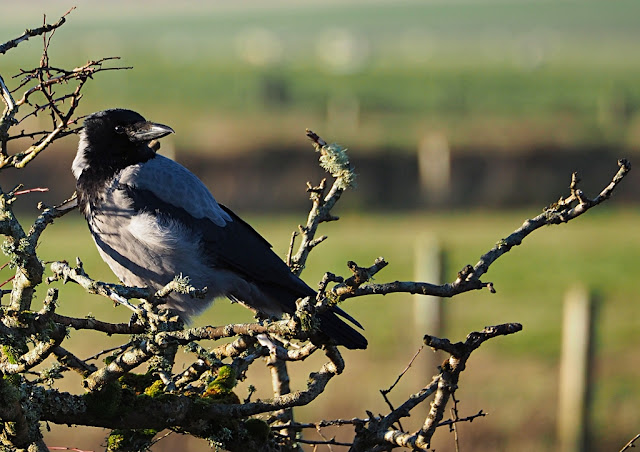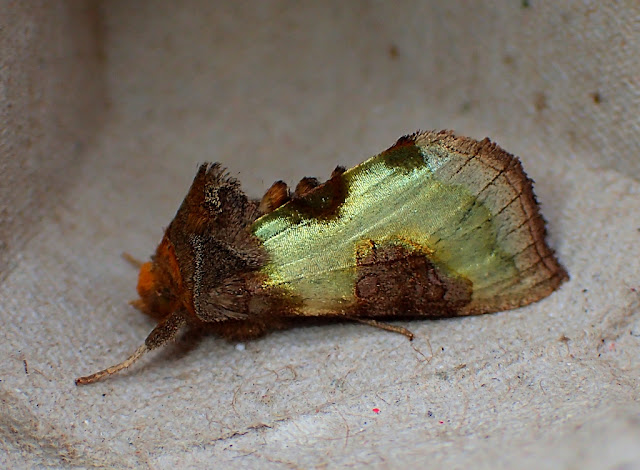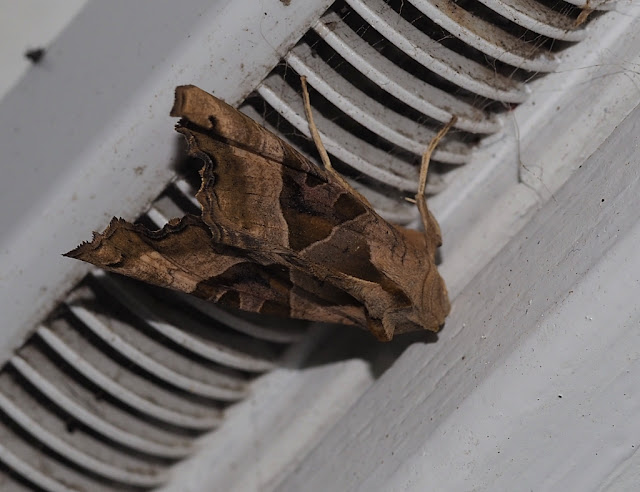Late on Tuesday afternoon we drove over the hill to Cottascarth RSPB, the reserve which has a building, more like a small house than a hide. The Eddie Balfour hide, to honour, Eddie, the man responsible for a forty three year study of Hen Harriers in Orkney.
We'd gone to count the roost at the reserve as it was a calm evening and a good opportunity to see a few raptors and whatever else might decide to fly by in the late afternoon light.
We'd been there a while and it had been all action with Common Buzzards and Hen Harriers scooting about and above the hillside when Louise, distracted, took a look back down the path we had tramped to get to the hide. "There's a birder coming along."
But no one arrived. We continued to watch the raptorial show, but Louise was a tad concerned. I suggested that she might have glimpsed Eddie himself, he died in 1974, so perhaps she had glimpsed a sphectre?
Eventually, we left the hide and headed back to the car park with Louise continuing to wonder what she had seen. I didn't admit that I was aware that birders often don't use the hide because it's design is such that it is not the best place to observe the moorland roost, it's better for a more panoramic view to sit outside in whatever shelter can be found. We tramped on and even quite close to our car no other vehicle was obvious, due to the lie of the land. Of course I made the most of this! Louise was somewhat relieved when a local birder's car eventually revealed itself.
I've been reading the above book, available still. I have to be honest though, aside from Eddie's own writings some of which are included, and Eric Meek's introduction it's not the best read. Eddie was the RSPB's first employee in Orkney, employed as their "Watcher" for £100 a year in 1953. At the time he was still driving school buses but when that work ended in 1956 the RSPB employed him further for £250 a year (the value of this today is just under £6,000 so Eddie must have had other work as well). I get the impression he was a bit of a law unto himself and managed his activities much as he saw fit. His work on Hen Harriers was ground breaking and he worked out much about their polygamous nesting behaviour, aging and importantly, their feeding strategies and prey. Eddie died in 1974, aged about 66. He'd had a day out with friends and researchers ringing Fulmar chicks on Gairsay, had dropped his ringing pliers and gone back in a rush to fetch them. On returning to Mainland, as everyone was getting into their vehicles, Eddie was chatting with one of his companions, he suddenly collapsed and attempts to revive him were unsuccessful.
 |
Hen Harrier over our neighbour's house, this autumn it seems that this individual (I'm guessing) has hunted here quite frequently. At the moment the trees harbour Redwings and Blackbirds, a welcome snack for a hungry harrier.
|
The thrush movements here this autumn have been more of a trickle than a rush, a few hundred in a day being the maximum count I've made.
The Long-tailed Duck remains on The Shunan and the injured Jackdaw that has been regular around the feeders is improving and can now fly over the house.
 | | |
| Drake Wigeon and Long-tailed Duck. |
|
|
 |
| Jackdaw. |
I'm slowly making progress with writing up my birding here. A slow job, but enjoyable. I'll put a link on the blog when I've written few more species.
Yesterday, the Kowas were back home. Viking Optical seem to have done a good job, and it's nice to have them back. Fortunately I still had a couple of pairs of Nikons to fall back on.
We had to have our last cat put down last week. Lots of birders don't like cats, and I have some issues with them myself, but living in the countryside they do help keep rats and mice out of the house. Ours rarely seemed to kill birds, but did kill quite a lot of Orkney Voles. However, the population of voles around the house and garden didn't appear to suffer, and we compensated by putting a larger part of the garden to suitable vole habitat. In recent years rabbit has been the main prey species and as we are inundated with the vegetable garden destroyers that seemed ok.
Our two cats came from North Yorkshire but had an Orkney connection as we got them from Giles and Mary Heron, our close neighbours there. Giles was Patrick Heron's twin brother, Patrick being one of the St Ives artists and there are two paintings of his in the permanent collection of the Pier Arts Centre, Stromness, which Giles and Patrick's niece was involved in designing. Ok, that's a bit obtuse... Anyway, Flame was 16, his sister, Socks, was 15 when we had the same decision to make last year. They miaowed all the way here when I brought them up in the Fiesta in October 2009, with two goldfish and a hamster.
 |
| Flame. |















































